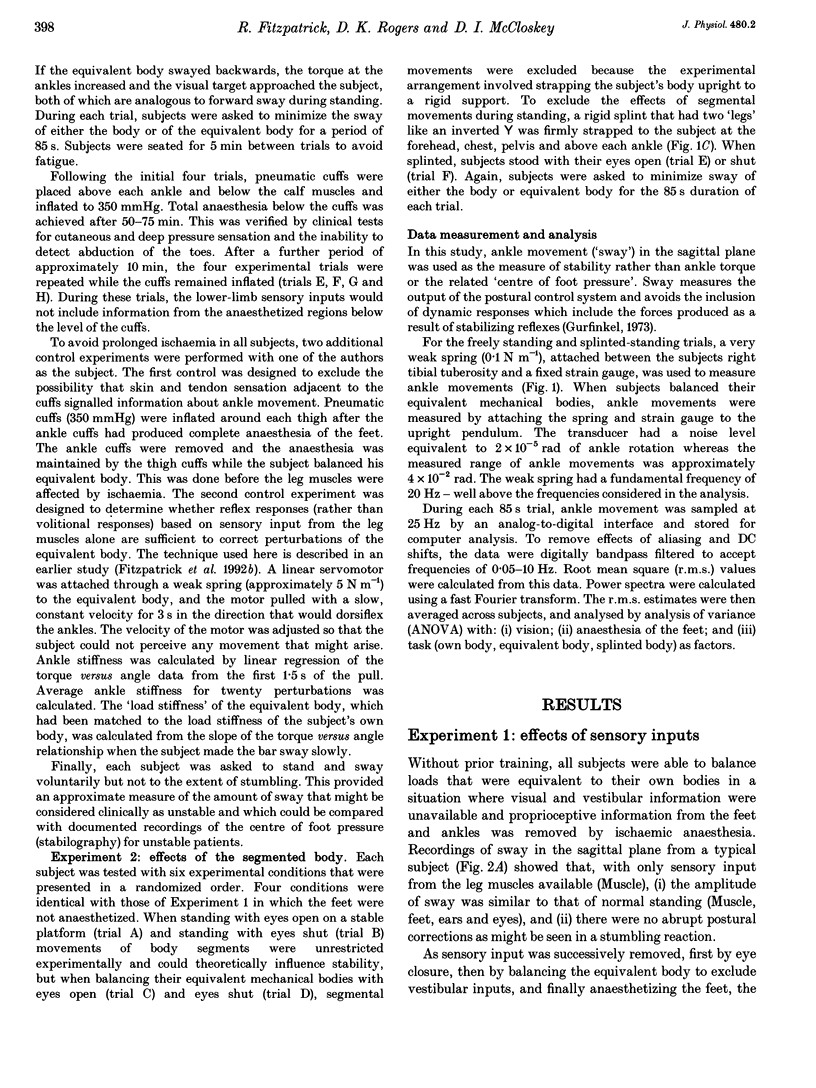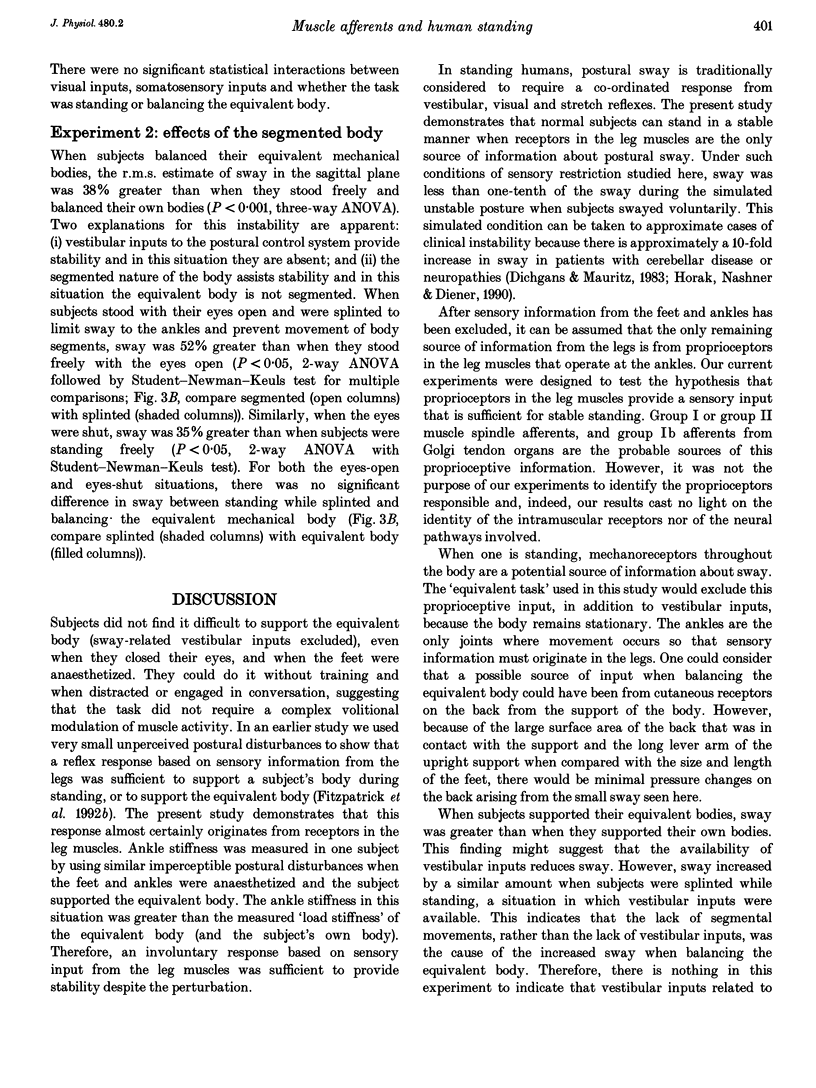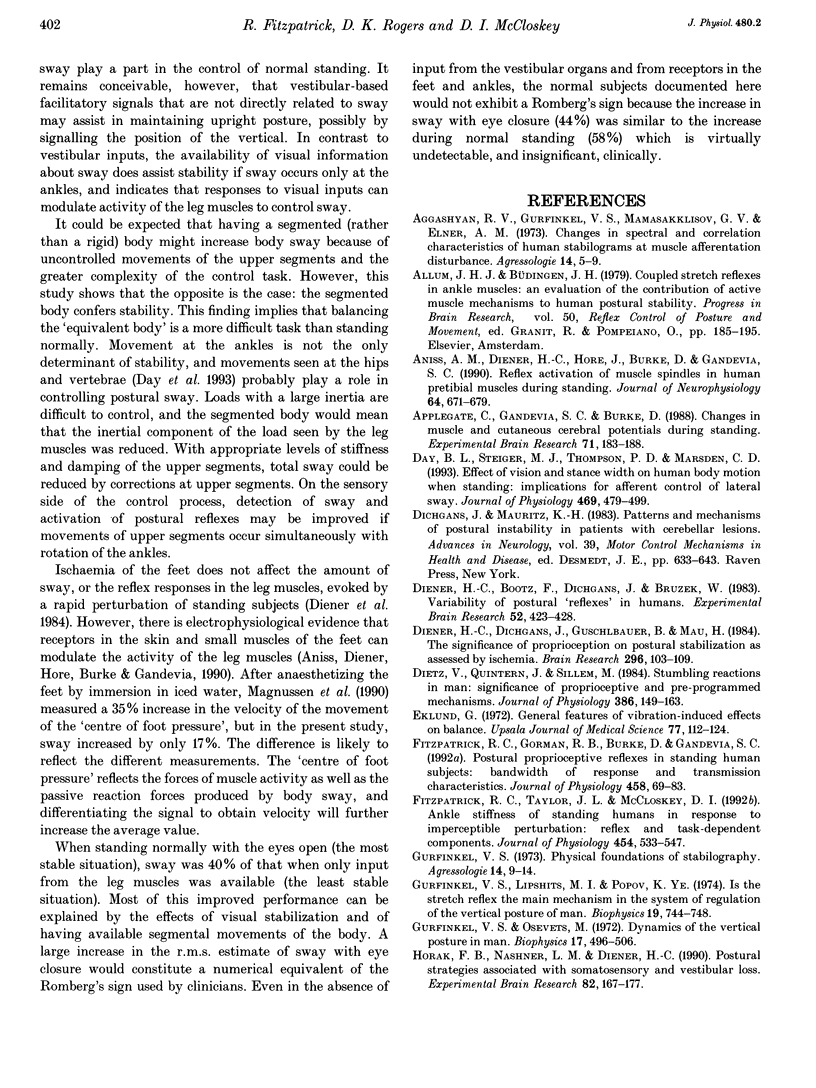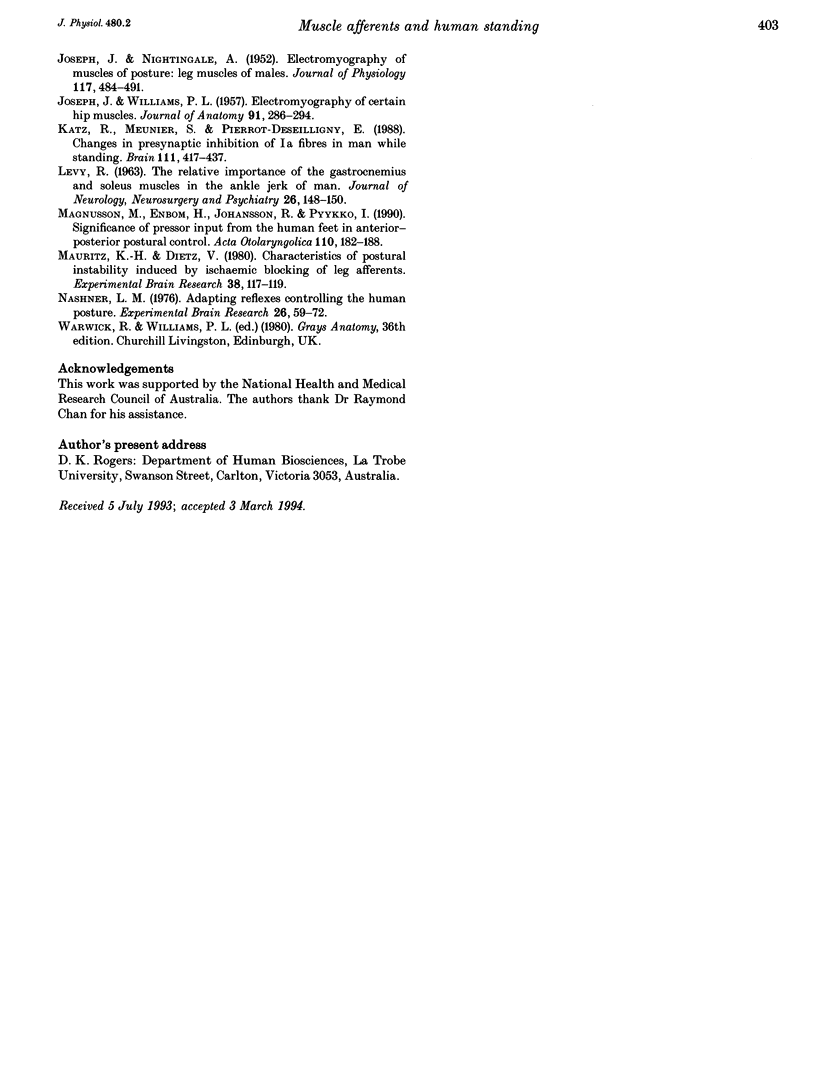Abstract
1. This study investigated the sources of sensory information upon which normal subjects' ability to stand depends. 2. An 'equivalent body' was used to simulate the physical properties of each subject's body during standing. The modulation of ankle torque required to support the equivalent body in an upright position was similar to that required to support the subject's own body when standing. However, when balancing the equivalent body, vestibular inputs were excluded from directing the appropriate changes in ankle torque. Thus, stability of stance could be studied with (normal stance) and without (balancing equivalent body) modulation by vestibular inputs. Vision could be excluded by closing the eyes. Sensory input from the feet and ankles could be removed by local anaesthesia from prolonged ischaemia, induced by occluding blood flow with inflated pneumatic cuffs just above the ankles. With vestibular, visual and peripheral sensory inputs negated, standing could rely only upon remaining sensory inputs, notably those from sensory receptors in the leg muscles. 3. Unlike the human body, the equivalent body used to negate vestibular inputs is not segmented. Therefore, the effects on stability of having a segmented body were determined by splinting subjects during standing so that only ankle movement was possible. This was done in the presence and absence of visual stabilization. 4. For each experimental task, either standing or balancing the equivalent body, sway was recorded while posture was unperturbed. Root mean square values of sway amplitude and power spectra were used to compare conditions. 5. Every subject could balance the equivalent body in a stable way when the eyes were closed, and when the feet were anaesthetized.(ABSTRACT TRUNCATED AT 250 WORDS)
Full text
PDF








Images in this article
Selected References
These references are in PubMed. This may not be the complete list of references from this article.
- Aggashyan R. V., Gurfinkel V. S., Mamasakhlisov G. V., Elner A. M. Changes in spectral and correlation characteristics of human stabilograms at muscle afferentation disturbance. Agressologie. 1973;14(SPEC):5–9. [PubMed] [Google Scholar]
- Allum J. H., Büdingen H. J. Coupled stretch reflexes in ankle muscles: an evaluation of the contributions of active muscle mechanisms to human posture stability. Prog Brain Res. 1979;50:185–195. doi: 10.1016/S0079-6123(08)60819-5. [DOI] [PubMed] [Google Scholar]
- Aniss A. M., Diener H. C., Hore J., Burke D., Gandevia S. C. Reflex activation of muscle spindles in human pretibial muscles during standing. J Neurophysiol. 1990 Aug;64(2):671–679. doi: 10.1152/jn.1990.64.2.671. [DOI] [PubMed] [Google Scholar]
- Applegate C., Gandevia S. C., Burke D. Changes in muscle and cutaneous cerebral potentials during standing. Exp Brain Res. 1988;71(1):183–188. doi: 10.1007/BF00247533. [DOI] [PubMed] [Google Scholar]
- Day B. L., Steiger M. J., Thompson P. D., Marsden C. D. Effect of vision and stance width on human body motion when standing: implications for afferent control of lateral sway. J Physiol. 1993 Sep;469:479–499. doi: 10.1113/jphysiol.1993.sp019824. [DOI] [PMC free article] [PubMed] [Google Scholar]
- Dichgans J., Mauritz K. H. Patterns and mechanisms of postural instability in patients with cerebellar lesions. Adv Neurol. 1983;39:633–643. [PubMed] [Google Scholar]
- Diener H. C., Bootz F., Dichgans J., Bruzek W. Variability of postural "reflexes" in humans. Exp Brain Res. 1983;52(3):423–428. doi: 10.1007/BF00238035. [DOI] [PubMed] [Google Scholar]
- Diener H. C., Dichgans J., Guschlbauer B., Mau H. The significance of proprioception on postural stabilization as assessed by ischemia. Brain Res. 1984 Mar 26;296(1):103–109. doi: 10.1016/0006-8993(84)90515-8. [DOI] [PubMed] [Google Scholar]
- Dietz V., Quintern J., Sillem M. Stumbling reactions in man: significance of proprioceptive and pre-programmed mechanisms. J Physiol. 1987 May;386:149–163. doi: 10.1113/jphysiol.1987.sp016527. [DOI] [PMC free article] [PubMed] [Google Scholar]
- Eklund G. General features of vibration-induced effects on balance. Ups J Med Sci. 1972;77(2):112–124. doi: 10.1517/03009734000000016. [DOI] [PubMed] [Google Scholar]
- Fitzpatrick R. C., Gorman R. B., Burke D., Gandevia S. C. Postural proprioceptive reflexes in standing human subjects: bandwidth of response and transmission characteristics. J Physiol. 1992 Dec;458:69–83. doi: 10.1113/jphysiol.1992.sp019406. [DOI] [PMC free article] [PubMed] [Google Scholar]
- Fitzpatrick R. C., Taylor J. L., McCloskey D. I. Ankle stiffness of standing humans in response to imperceptible perturbation: reflex and task-dependent components. J Physiol. 1992 Aug;454:533–547. doi: 10.1113/jphysiol.1992.sp019278. [DOI] [PMC free article] [PubMed] [Google Scholar]
- Gurfinkel E. V. Physical foundations of stabilography. Agressologie. 1973 Sep;14(SPEC):9–13. [PubMed] [Google Scholar]
- Horak F. B., Nashner L. M., Diener H. C. Postural strategies associated with somatosensory and vestibular loss. Exp Brain Res. 1990;82(1):167–177. doi: 10.1007/BF00230848. [DOI] [PubMed] [Google Scholar]
- JOSEPH J., NIGHTINGALE A. [Electromyography of muscles of posture: leg muscles in males]. J Physiol. 1952 Aug;117(4):484–491. doi: 10.1113/jphysiol.1952.sp004762. [DOI] [PMC free article] [PubMed] [Google Scholar]
- JOSEPH J., WILLIAMS P. L. Electromyography of certain hip muscles. J Anat. 1957 Apr;91(2):286–294. [PMC free article] [PubMed] [Google Scholar]
- Katz R., Meunier S., Pierrot-Deseilligny E. Changes in presynaptic inhibition of Ia fibres in man while standing. Brain. 1988 Apr;111(Pt 2):417–437. doi: 10.1093/brain/111.2.417. [DOI] [PubMed] [Google Scholar]
- LEVY R. The relative importance of the gastrocnemius and soleus muscles in the ankle jerk of man. J Neurol Neurosurg Psychiatry. 1963 Apr;26:148–150. doi: 10.1136/jnnp.26.2.148. [DOI] [PMC free article] [PubMed] [Google Scholar]
- Magnusson M., Enbom H., Johansson R., Pyykkö I. Significance of pressor input from the human feet in anterior-posterior postural control. The effect of hypothermia on vibration-induced body-sway. Acta Otolaryngol. 1990 Sep-Oct;110(3-4):182–188. doi: 10.3109/00016489009122535. [DOI] [PubMed] [Google Scholar]
- Mauritz K. H., Dietz V. Characteristics of postural instability induced by ischemic blocking of leg afferents. Exp Brain Res. 1980;38(1):117–119. doi: 10.1007/BF00237939. [DOI] [PubMed] [Google Scholar]
- Nashner L. M. Adapting reflexes controlling the human posture. Exp Brain Res. 1976 Aug 27;26(1):59–72. doi: 10.1007/BF00235249. [DOI] [PubMed] [Google Scholar]




